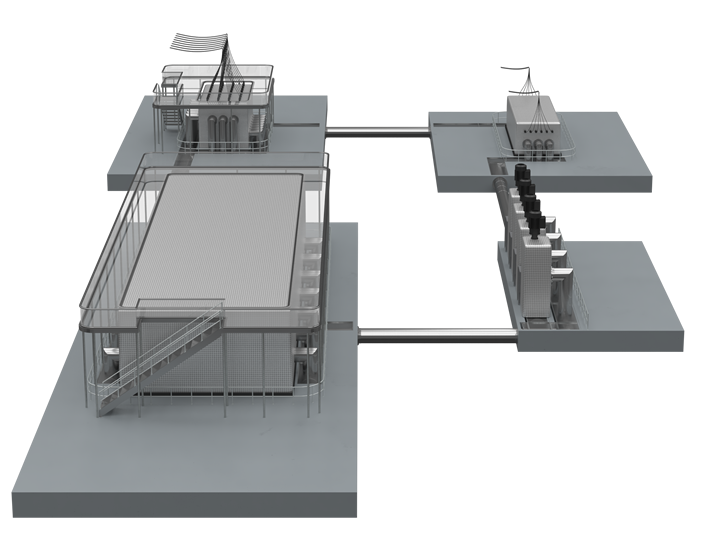Relying on lithium-ion batteries, which are expensive and require the mining of critical minerals, will not be sufficient or even feasible for the scale at which we will need energy storage to achieve a fully renewable grid.
 Thermal Battery Technology
Thermal Battery Technology

Q&A with Arvin Ganesan, CEO | Fourth Power
Tell us about yourself and your role with Fourth Power.
My journey to Fourth Power is a culmination of diverse experiences. I joined the company as CEO last year after leading Apple’s Global Energy and Environmental Policy team for over five years. Between that position, where I worked on reshaping market and policy structures to drive rapid decarbonization and being appointed by President Obama to lead policy development work at EPA, I honed an understanding of what needs to happen in the energy space to propel the energy transition.
So when the chance to lead a startup focused on developing utility-scale thermal batteries with the mission to eliminate our dependence on fossil fuels emerged, I knew it was time to leverage that expertise. I am excited to help bring Fourth Power’s vision to reality, ultimately ensuring the creation of a national grid that is not only cleaner but also more cost-effective and reliable for its customers.
How does Fourth Power’s technology work? Why did the company decide to enter the thermal battery space?
Let me start by saying that Fourth Power's technology is the direct result of the unwavering commitment of our Founder and CTO, Prof. Asegun Henry, and his engineering teams, who have worked tirelessly within MIT and Georgia Tech laboratories over the last decade. Their scientific understanding and determination to push the boundaries of what is possible shaped Fourth Power into the transformative and innovative company it is today.
At a very high level, our system captures curtailed renewable energy and uses it to power an industrial-sized furnace, which converts that electricity into heat, where it can be stored in carbon blocks for as long as a month. Then, the system can convert heat to electricity and dispatch it to the grid on demand.
At a slightly more granular level, the system uses extremely high temperatures – up to 2400 degrees Celsius – to pump melted tin through graphite pipes, transferring the heat into insulated carbon blocks. When the grid requires electricity, that same piping system transports the heat to a power block, where the heat is then reconverted back into electricity utilizing thermophotovoltaic (TPV) cells, similar to how the sun’s light is converted to energy using solar panels (or PV cells). This purposeful design enables us to respond to grid requirements within seconds.
Our system, set to be roughly half the size of a football field in an entirely commercial operation, is built with a focus on modularity. This modular approach allows us to seamlessly grow with the grid by incorporating additional storage blocks, catering to anywhere between five and 500 hours of duration.
Fourth Power became a thermal battery company partially because of the trajectory of Aseguns research but also because we need alternative energy storage to achieve grid decarbonization. Relying on lithium-ion batteries, which are expensive and require the mining of critical minerals, will not be sufficient or even feasible for the scale at which we will need energy storage to achieve a fully renewable grid. Our technology can make renewable energy cost-competitive and as reliable as fossil fuels.
What technological advancements set Fourth Power's thermal battery apart from options currently available?
Asegun and our engineering team have constantly challenged the boundaries of current scientific norms to improve our thermal battery design continuously. Fourth Power’s signature high operating temperatures, for instance, earned a Guinness World Record after we successfully pumped liquid tin at an extraordinary 1200°C, pushing the limits of what was once considered possible. Our distinctive thermophotovoltaic (TPV) cell design also set a world record for reaching 41% efficiency – surpassing even the efficiency of the average turbine-based heat engine in the United States.
Operating at higher temperatures and efficiency can generate more heat transfer for increased power output at a reduced system cost.

Each subsystem of Fourth Power’s thermal battery is separately housed, allowing energy and power to be scaled independently.
What sort of applications would Fourth Power’s thermal battery be used for? Who will be Fourth Power’s typical customers?
Electricity and industrial heat take center stage in our efforts. Specifically, we aim to replace fossil fuel peaker plants in electricity generation with our thermal battery. The ultimate objective is to ensure that each new power plant integrates renewable energy and thermal storage solutions, thereby eliminating additional natural gas requirements.
As for our customers, we anticipate working extensively with utilities across the country who are both committed to improving grid efficiency and delivering affordable clean energy solutions to their ratepayers.
What makes thermal battery technology different from conventional chemistry-based batteries? What are the advantages of utilizing thermal batteries as opposed to other types of technologies?
In a traditional electrochemical battery, energy storage revolves around potential energy exchanges, wherein chemical bonds form and break among specific atoms. Select atoms responsible for these bonding actions constitute only a fraction of the overall battery composition. Alternatively, thermal batteries, including Fourth Power’s solution, present a distinctive approach given they employ kinetic energy. Every atom within the battery actively participates, rhythmically vibrating as they speed up and slow down to create energy.
Despite the individual atoms storing less energy in the thermal process, the significant involvement of nearly every atom results in energy densities comparable to those achieved by traditional batteries like lithium-ion.
A critical advantage of thermal batteries becomes apparent when considering the typical lifespan issues encountered with conventional batteries. Continually creating and breaking bonds in regular batteries often leads to unintended side reactions and mechanical wear, affecting longevity. Because we are not swapping any bonds, a thermal battery is entirely inert, meaning the materials these systems are made of do not want to react with one another. As such, thermal batteries promise an extended and robust lifespan.
When energy is stored thermally, the emphasis is less on the meticulous control of atomic interactions and more on the atoms' presence. This flexibility enables using raw materials, such as naturally occurring substances like dirt, which require minimal processing to transform into efficient energy storage mediums. This simplicity helps keep overall system costs low and ensures a more reliable supply chain.
What are the biggest challenges facing the success of grid-scale technologies and thermal batteries in particular?
The biggest challenge with the mainstream adoption of grid-scale technologies is integrating with utilities. Utilities have a tough job: keeping the lights on and bills low for their ratepayers. As such, they’re often hypercritical of the technologies they integrate into their systems for fear of risking their reliability or affordability. As grid-scale battery providers, we cannot expect them to suddenly shift from a tried and true technology to a new solution. To win over utilities, you have to show your receipts because, ultimately, they have a grid to manage and millions of ratepayers to service.
Keeping this in mind, our team at Fourth Power has meticulously designed our system to seamlessly integrate into existing utility business models, showcasing enhanced reliability and ensuring optimal economic value. We've adopted a data-driven approach and invested time in comprehending the motivating factors of utilities.
As for thermal batteries, the primary inhibitor has genuinely been a lack of technological innovation to create a superior system. Before our innovations, the thermal fluid infrastructure had seen little change for almost a century. The widespread use of PVC, steel, or nickel-alloy pipes has long been the norm, and that's the path everyone else has been following. We didn’t want to follow in history’s familiar footprints – we wanted to write a new future.
How will utility-scale battery storage technologies contribute to the broader vision of building a more sustainable grid in the future? What attributes are essential for the success of these technologies?
In today's electric grid scenario, the demand for storage spans anywhere from five to 10 hours. However, studies suggest that our storage requirements will also increase as more renewable projects come online. As such, ample utility-scale batteries will be essential to build a national grid fully powered by renewable energy. These facilities will capture and store excess solar and wind generation, ensuring a reservoir of power for use during periods when the sun isn't shining and the wind isn't blowing.
But to make a substantial impact, these facilities need a crucial feature: flexibility. Instead of committing to one solution now and changing it later – or burdening ratepayers with unnecessary costs by starting with a massive battery – the storage facilities we build today should be adaptable enough to handle the nation's current and upcoming electricity needs. A majority of the grid-scale solutions currently available are focused on addressing long-duration demands (approximately 100 hours), making them ill-fitted for our current energy needs.
At Fourth Power, we created our thermal battery solution with this crucial attribute in mind. Our modular system makes it easy and affordable to add more storage capacity as more renewable generation is introduced. Growing seamlessly with the grid, our solution provides durations spanning five to 500 hours, guaranteeing cost-effective adaptability to current and future market needs.

Arvin Ganesan became Fourth Power’s CEO in 2023 following a distinguished five-year tenure as the Head of Global Energy and Environmental Policy at Apple. He brings extensive expertise in energy markets, having held leadership positions with Advanced Energy Economy and the U.S. EPA, where he was appointed by President Barack Obama.
The content & opinions in this article are the author’s and do not necessarily represent the views of AltEnergyMag
Comments (0)
This post does not have any comments. Be the first to leave a comment below.
